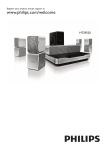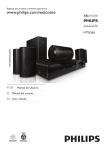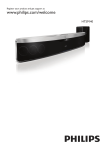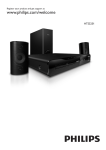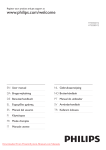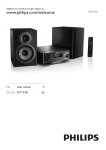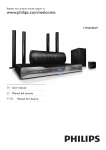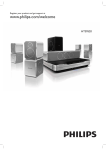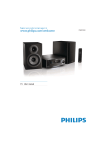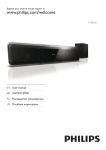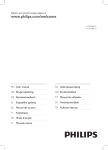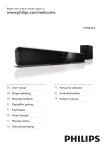Download Philips 2.1 Home theater HTS5220
Transcript
Register your product and get support at www.philips.com/welcome HTS5220 EN User manual RU Руководство пользователя UK Посібник користувача 1 Notice Copyright About Progressive Scan Compliance Open source software Trademarks 2 Important Safety Product care Disposal of your old product and batteries 3D health warning 3 Your home theater Main unit Remote control 6 2 2 2 2 2 2 4 4 4 5 5 6 6 6 Change settings 20 20 20 20 21 21 21 22 Access the setup menu Change video settings Change audio settings Set up network Set up EasyLink Change preference settings Change advanced settings 7 Update software Check software version Update software from the network Update software from a USB 23 23 23 23 8 Product specifications 24 9 Troubleshooting 25 10 Index 4 Connect your home theater Connectors Connect to the TV Connect audio from TV or other devices Connect a Philips Dock for iPod/iPhone Connect to a computer network and the Internet Connect a Wi-Fi USB adapter 5 Use your home theater Before you start Access the home menu Choose your sound Play a disc Use Bonus View on Blu-ray Access BD-Live on Blu-ray Play 3D video Play from a USB storage device More play features for disc or USB Play from PC (DLNA) Play from radio Play audio from TV or other devices Play from an MP3 player Play from an iPod or iPhone Use Philips EasyLink 27 8 8 9 10 10 10 11 12 12 12 12 13 14 14 14 15 15 16 17 18 18 18 19 EN 1 English Contents 1 Notice Copyright This item incorporates copy protection technology that is protected by U.S. patents and other intellectual property rights of Rovi Corporation. Reverse engineering and disassembly are prohibited. About Progressive Scan Consumers should note that not all high definition television sets are fully compatible with this product and may cause artifacts to be displayed in the picture. In case of 525 or 625 progressive scan picture problems, it is recommended that the user switch the connection to the ‘standard definition’ output. If there are questions regarding our TV set compatibility with this model 525p and 625p DVD player, please contact our customer service center. Compliance This product is in compliance with the essential requirements and other relevant provisions of Directives 2006/95/EC (Low Voltage), 2004/108/ EC (EMC). Open source software Philips Electronics Singapore Pte Ltd hereby offers to deliver, upon request, a copy of the complete corresponding source code for the copyrighted open source software packages used in this product for which such offer is requested by the respective licenses. This offer is valid up to three years after product purchase to anyone in receipt of this information. To obtain source code, please contact [email protected]. If you prefer not to use email or if you do not receive confirmation receipt within a week after mailing to this email address, please write in English to “Open Source Team, Philips Intellectual Property & Standards, P.O. Box 220, 5600 AE Eindhoven, The Netherlands”. If you do not receive timely confirmation of your letter, please email to the email address above. The texts of the licenses and acknowledgements for open source software used in this product are included on a separate leaflet. Trademarks “Blu-ray 3D” and “Blu-ray 3D” logo are trademarks of Blu-ray Disc Association. BONUSVIEW™ ‘BD LIVE’ and ‘BONUSVIEW’ are trademarks of Blu-ray Disc Association. Java and all other Java trademarks and logos are trademarks or registered trademarks of Sun Microsystems, Inc. in the United States and/or other countries. ‘AVCHD’ and ‘AVCHD’ logo are trademarks of Matsushita Electric Industrial Co., Ltd and Sony Corporation. 2 EN DLNA , the DLNA Logo and DLNA CERTIFIED are trademarks, service marks, or certification marks of the Digital Living Network Alliance. Manufactured under license from Dolby Laboratories. Dolby and the double-D symbol are trademarks of Dolby Laboratories. Manufactured under license under U.S. Patent #’s: 5,451,942; 5,956,674; 5,974,380; 5,978,762; 6,226,616; 6,487,535; 7,392,195; 7,272,567; 7,333,929; 7,212,872 & other U.S. and worldwide patents issued & pending. DTS and the Symbol are registered trademarks, & DTS-HD, and DTSHD Master Audio | Essential and the DTS logos are trademarks of DTS, Inc. Product includes software. DTS, Inc. All Rights Reserved. English ‘x.v.Colour’ is a trademark of Sony Corporation. locate the DivX VOD section in your device setup menu. Go to vod.divx.com with this code to complete the registration process and learn more about DivX VOD. Windows Media and the Windows logo are trademarks, or registered trademarks of Microsoft Corporation in the United States and/ or other countries. HDMI, and HDMI logo, and High-Definition Multimedia Interface are trademarks or registered trademarks of HDMI licensing LLC in the United States and other countries. The USB-IF Logos are trademarks of Universal Serial Bus Implementers Forum, inc. LASER RADIATION DO NOT VIEW DIRECTLY WITH OPTICAL INSTRUMENTS CLASS 1M LASER PRODUCT DivX , DivX Certified and associated logos are registered trademarks of DivX, Inc. and are used under license. DivX Ultra Certified to play DivX video with advanced features and premium content. ABOUT DIVX VIDEO: DivX is a digital video format created by DivX, Inc. This is an official DivX Certified device that plays DivX video. Visit www.divx.com for more information and software tools to convert your files into DivX video. ABOUT DIVX VIDEO-ON-DEMAND: This DivX Certified device must be registered in order to play DivX Video-on-Demand (VOD) content. To generate the registration code, EN 3 2 Important Read and understand all instructions before you use your home theater. If damage is caused by failure to follow instructions, the warranty does not apply. Safety Risk of electric shock or fire! • Never expose the product and accessories to rain or water. Never place liquid containers, such as vases, near the product. If liquids are spilt on or into the product, disconnect it from the power outlet immediately. Contact Philips Consumer Care to have the product checked before use. • Never place the product and accessories near naked flames or other heat sources, including direct sunlight. • Never insert objects into the ventilation slots or other openings on the product. • Where the mains plug or an appliance coupler is used as the disconnect device, the disconnect device shall remain readily operable. • Disconnect the product from the power outlet before lightning storms. • When you disconnect the power cord, always pull the plug, never the cable. Risk of short circuit or fire! • Before you connect the product to the power outlet, ensure that the power voltage matches the value printed on the back or bottom of the product. Never connect the product to the power outlet if the voltage is different. Risk of injury or damage to the home theater! • For wall-mountable products, use only the supplied wall mount bracket. Secure the wall mount to a wall that can support the combined weight of the product and the wall mount. Koninklijke Philips Electronics N.V. bears no responsibility for improper wall mounting that results in accident, injury or damage. 4 EN • For speakers with stands, use only the supplied stands. Secure the stands to the speakers tightly. Place the assembled stands on flat, level surfaces that can support the combined weight of the speaker and stand. • Never place the product or any objects on power cords or on other electrical equipment. • If the product is transported in temperatures below 5°C, unpack the product and wait until its temperature matches room temperature before connecting it to the power outlet. • Visible and invisible laser radiation when open. Avoid exposure to beam. • Do not touch the disc optical lens inside the disc compartment. Risk of overheating! • Never install this product in a confined space. Always leave a space of at least four inches around the product for ventilation. Ensure curtains or other objects never cover the ventilation slots on the product. Risk of contamination! • Do not mix batteries (old and new or carbon and alkaline, etc.). • Remove batteries if they are exhausted or if the remote control is not to be used for a long time. • Batteries contain chemical substances, they should be disposed of properly. Product care • • • • Do not insert any objects other than discs into the disc compartment. Do not insert warped or cracked discs into the disc compartment. Remove discs from the disc compartment if you are not using the product for an extended period of time. Only use microfiber cloth to clean the product. Your product is designed and manufactured with high quality materials and components, which can be recycled and reused. When this crossed-out wheeled bin symbol is attached to a product it means that the product is covered by the European Directive 2002/96/ EC. Please inform yourself about the local separate collection system for electrical and electronic products. Please act according to your local rules and do not dispose of your old products with your normal household waste. Correct disposal of your old product helps to prevent potential negative consequences for the environment and human health. 3D health warning If you or your family has a history of epilepsy or photosensitive seizures, consult a medical professional before exposing yourself to flashing light sources, rapid image sequences or 3D viewing. To avoid discomfort such as dizziness, headache or disorientation, we recommend not watching 3D for extended periods of time. If you experience any discomfort, stop watching 3D and do not immediately engage in any potentially hazardous activity (for example driving a car) until your symptoms have disappeared. If symptoms persist, do not resume watching 3D without consulting a medical professional first. Parents should monitor their children during 3D viewing and ensure they do not experience any discomfort as mentioned above. Watching 3D is not recommended for children under six years of age as their visual system is not fully developed yet. Your product contains batteries covered by the European Directive 2006/66/EC, which cannot be disposed with normal household waste. Please inform yourself about the local rules on separate collection of batteries because correct disposal helps to prevent negative consequences for the environmental and human health. EN 5 English Disposal of your old product and batteries 3 Your home theater Remote control Congratulations on your purchase, and welcome to Philips! To fully benefit from the support that Philips offers, register your home theater at www. philips.com/welcome. 1 19 Main unit 2 18 3 4 5 17 6 16 15 a +/Increases or decreases volume. 7 8 9 10 14 b Display panel c (Play/Pause) Starts, pauses or resumes play. d (Stop) Stops play. In radio mode, erases the current preset radio station. e (Eject) Ejects the disc from the disc compartment. f Disc compartment g (Standby-On) Switches the home theater on or to standby. h SOURCE Selects an audio/video source for the home theater. 6 EN 11 13 12 (Standby-On) Switches the home theater on or to standby. • When EasyLink is enabled, press and hold for at least three seconds to switch all connected HDMI CEC compliant devices to standby. • b (Home) Accesses the home menu. c SOUND SETTINGS Accesses or exits various sound options. d Navigation buttons • Navigates menus. • In radio mode, press left or right to start auto search. e OK • Confirms an entry or selection. f OPTIONS Accesses more play options during playback. • In radio mode, programs radio stations. o (Stop) / (Eject / Open/Close) Stops play. Press and hold to eject the disc or open the disc compartment. • In radio mode, erases the current preset radio station. • • p (Mute) Mutes or restores volume. q BACK Returns to a previous menu screen. English a r POP-UP MENU/DISC MENU Accesses or exits the disc menu. s Source buttons • Color buttons (for Blu-ray discs): • • • • • Selects tasks or options. DISC: Switches to disc source. RADIO: Switches to FM radio. DOCK for iPod: Switches to Philips Dock for iPod/iPhone. SOURCE : Selects an audio input source. g +/- ( Volume) Increases or decreases volume. h (Play) Starts or resumes play. i (Pause) Pauses play. j / (Fast Backward/Fast Forward) Fast backwards or fast forwards. Press repeatedly to change the search speed. k Alphanumeric buttons Enters values or letters (using SMS style entry). l SUBTITLE Selects subtitle language for video. m TOP MENU Accesses the main menu of a video disc. n • • / (Previous/Next) Skips to the previous or next track, chapter or file. In radio mode, selects a preset radio station. EN 7 4 Connect your home theater Back connectors This section helps you connect your home theater to a TV and other devices. The basic connections of the home theater with its accessories are provided in the Quick Start. For a comprehensive interactive guide, see www.connectivityguide. philips.com. Note • Refer to the type plate at the back or bottom of the product for identification and supply ratings. • Before you make or change any connections, ensure that all devices are disconnected from the power outlet. a LAN Connects to the LAN input on a broadband modem or router. b HDMI OUT (ARC) Connects to the HDMI input on the TV. Connectors Connect other devices to your home theater. Side connectors c VIDEO OUT-VIDEO Connects to the composite video input on the TV. d VIDEO OUT-Y Pb Pr Connects to the component video input on the TV. e DOCK for iPod Connects to a Philips Dock for iPod/iPhone. (Model: Philips DCK3060) f DIGITAL IN-COAXIAL Connects to the coaxial audio output on the TV or a digital device. g SPEAKERS/SUBWOOFER Connects to the supplied speakers and subwoofer. h AUDIO IN - AUX 1/AUX 2 a MP3 LINK Audio input from an MP3 player. b (USB) Audio, video or picture input from a USB storage device. c Wi-Fi Connects to a Wi-Fi USB adapter.(Model: Philips WUB1110, sold separately.) 8 EN Connects to the analog audio output on the TV or an analog device. i AC MAINS~ Connects to the power supply. j ANTENNA FM 75 Connects the FM antenna for radio reception. Connect to the TV Component Video Out English TV Connect your home theater directly to a TV through one of the following connectors (from highest to basic quality video): Component Video In a HDMI b Component video c Composite video Option 1: Connect to the TV through HDMI Note • The HDMI connector on the TV might be labeled HDMI IN or HDMI ARC . • If the TV supports HDMI Audio Return Channel (ARC), you can use it to output digital audio to the home theater. • If the HDTV has a DVI connector, connect using an HDMI/DVI adapter. • If the TV supports EasyLink HDMI CEC, control the home theater and TV with one remote control (see ‘Use Philips EasyLink’ on page 19). Option 3: Connect to the TV through composite video (CVBS) Note • The composite video cable or connector might be labeled AV IN , VIDEO IN , COMPOSITE or BASEBAND. (Cable not supplied) TV TV TV Option 2: Connect to the TV through YPbPr (component video) Note • The component video cable or connector might be labeled Y Cb Cr or YUV. (Cable not supplied) 2 1 EN 9 Connect audio from TV or other devices Use your home theater to play audio from the TV or other devices such as a cable box. Choose from the following connectors. Tip • Press SOURCE repeatedly to select the audio Option 2: Connect audio through coaxial cable Note • The digital coaxial cable or connector might be labeled COAXIAL/DIGITAL OUT or SPDIF OUT. (Cable not supplied) output of your connection. TV Option 1: Connect audio through analog audio cables (Cable not supplied) TV 1 2 Connect a Philips Dock for iPod/iPhone (Philips Dock for iPod/iPhone not supplied) DOCK for iPod 2 1 Connect to a computer network and the Internet Connect the home theater to a computer network and enjoy: • Multimedia content streamed from your computer : view photos, play music and watch video files streamed from your computer (see ‘Play from PC (DLNA)’ on page 16). 10 EN Software update : update the software of the home theater through the network (see ‘Update software from the network’ on page 23). What you need: • A network router (with DHCP enabled). • A network cable (RJ45 straight cable). • A computer with media server software installed (see ‘Set up media server software’ on page 17 ). • For software update, make sure that the network router has access to the Internet and is not restricted by firewalls or other security systems. Set up network 1 2 3 4 5 6 Caution • Familiarize yourself with the network router, media server software and networking principles before attempting to connect the home theater to a computer network. If necessary, read documentation accompanying network components. Philips is not responsible for lost, damaged or corrupt data. 7 Connect the home theater to a network router through wired or wireless network connection (see ‘Connect a Wi-Fi USB adapter’ on page 11). Turn on your TV and switch to the correct source for the home theater. Press (Home). Select [Setup], then press OK . Select [Network] > [Network Installation], then press OK . • For wired network, select [Wired (Ethernet)] and press OK . • For wireless network, select [Wireless (Wi-Fi)] and press OK . Follow the instructions on the TV to complete the setup. » The home theater connects to the internet. If connection fails, select [Retry], then press OK. Select [Finish], then press OK to exit. Connect a Wi-Fi USB adapter (Cable not supplied) Purchase a Wi-Fi USB adapter (model: PHILIPS WUB1110) and set up the wireless network (see ‘Set up network’ on page 11). LAN www EN 11 English • 5 Use your home theater Choose your sound This section helps you choose the ideal sound for your video or music. This section helps you use the home theater to play media from a wide range of sources. Before you start Check that you: • Make the necessary connections as described in the Quick Start and User Manual. • Switch the TV to the correct source for the home theater. Access the home menu The home menu gives you easy access to connected devices, audio and video settings, and other features. Press (Home). » The home menu appears. 1 2 Press the Navigation buttons and OK to select the following: • [play Disc] : Starts disc play. • [browse USB] : Accesses the content browser of the connected USB storage device. • [browse iPod] : Accesses the content browser of the connected iPod or iPhone. • [browse PC] : Accesses the content browser of the connected PC network. • [Setup] : Accesses menus to change picture, sound and other settings. 1 2 Press SOUND SETTINGS . Press the Navigation buttons (left/right) to access the sound options. Sound experience Description AUTO VOLUME Sets a constant output signal at the speaker output. This option is best for TV audio input where the commercial signal level is usually higher than the content. SOUND Selects a sound mode. SURROUND Selects a surround sound or stereo sound. TREBLE Adjusts the high frequency output. MID Adjusts the middle frequency output. BASS Adjusts the low frequency output. AUDIO SYNC Delays the audio to match the video. 3 4 Select an option, then press OK . Press BACK to exit. If you do not press a button within five seconds, it automatically exits the menu. Change auto volume Select the level of volume which output from your TV or other devices to the home theater. Press SOUND SETTINGS . Select AUTO VOLUME , then press OK . Press the Navigation buttons (up/down) to select ON or OFF. Press OK to confirm your choice. 1 2 3 4 12 EN Synchronize audio with video Select predefined sound modes to suit your video or music. Press SOUND SETTINGS . Select SOUND, then press OK . Press the Navigation buttons (up/down) to select the following settings: • ACTION/ROCK : Enhanced low and high-range. Ideal for action movies and rock or pop music. • DRAMA /JAZZ : Clear mid and highrange. Ideal for drama movies and jazz music. • CONCERT/CLASSIC: Neutral sound. Ideal for live concerts and classical music. • SPORTS : Moderate mid-range and surround effects for clear vocals and the atmosphere of a live sport venue. If the audio and video are not synchronized, you can delay the audio to match the video. Press SOUND SETTINGS . Select AUDIO SYNC , then press OK . Press the Navigation buttons (up/down) to sync the audio with the video. Press OK to confirm. 1 2 3 4 Press OK to confirm your choice. Change surround sound mode Experience an immersive audio experience with surround sound modes. Press SOUND SETTINGS . Select SURROUND, then press OK . Press the Navigation buttons (up/down) to select the following settings: • DOLBY VS : Dolby Virtual Speaker. • STEREO : Two-channel stereo sound. Ideal for listening to music. 1 2 3 4 Press OK to confirm your choice. 1 2 3 4 Play a disc The home theater can play a wide variety of discs, including video, audio and mixed media (for example, a CD-R that contains JPEG pictures and MP3 music). Insert a disc into the home theater. Press DISC , or select [play Disc] in the home menu and press OK . » The disc plays or the disc main menu appears. 1 2 3 Press the following buttons to control play: Button Action Navigation buttons OK Navigate menus. (Play) / / Change treble, mid and bass Change the high frequency (treble), mid frequency (mid) and low frequency (bass) settings of the home theater to suit your video or music. Press SOUND SETTINGS . Select TREBLE , MID or BASS , then press OK . Press the Navigation buttons (up/down) to adjust the frequency level. Press OK to confirm. 1 2 3 4 Navigation buttons (up/ down) SUBTITLE POP-UP MENU/DISC MENU OPTIONS Confirms an entry or selection. Starts or resumes play. Pauses play. Stops play. Skips to the previous or next track, chapter or file. Fast backwards or fast forwards. Press repeatedly to change the search speed. Rotates the picture counterclockwise or clockwise. Selects subtitle language for video. Accesses or exits the disc menu. Accesses more play options during playback. EN 13 English Change sound mode For video formats such as, DivX and WMV: • To stop play, press . • To resume the video from where you stopped, press (Play). • To play the video from the start, press OK . Note • To play DivX DRM - protected files from a disc or a USB storage device, connect your home theater to a TV through an HDMI cable. Use Bonus View on Blu-ray Blu-ray discs that support the Bonus View feature (also known as Picture-In-Picture) allow you to view special content such as a director’s commentary while watching the main feature. If necessary, enable BonusView (or PictureIn-Picture) in the Blu-ray disc menu. During playback of the main feature, press OPTIONS . » The options menu is displayed. Access BD-Live on Blu-ray BD-Live enabled Blu-ray discs include exclusive services such as movies and other online bonuses. Prepare the internet connection and set up the network (see ‘Connect to a computer network and the Internet’ on page 10). Connect the USB storage device to the home theater. Select the BD-Live icon in the disc menu, then press OK . » BD-Live starts to load. The loading time depends on the disc and your internet connection. 1 2 3 4 5 Press the Navigation buttons to navigate BD-Live. Press OK to select an item. Note 1 • The range of BD-Live services depends on 2 • When you use BD-Live, data on the disc and 3 4 5 Select [PIP Selection] > [PIP], then press OK . » PIP options [1]/[2] depend on the video contents. » The picture-in-picture video appears in a small window. Select [2nd Audio Language] or [2nd Subtitle Language], then press OK . Select the language to play, then press OK . Note • To turn off the Bonus View (Picture-in- Picture), press OPTIONS , select [PIP Selection] > [Off], then press OK . the disc. home theater are accessed by the content provider. • Use a USB storage device with at least 1 GB of free space to store the downloaded files. • If there is insufficient memory to download BD-Live content, clear memory space (see ‘Change advanced settings’ on page 22). Play 3D video Your home theater can play 3D videos on 3D TVs. Before you start, make sure that: • your TV is a 3D TV, and is connected to your home theater through HDMI, • your disc is a Blu-ray 3D disc, and • you have 3D glasses that are compatible with your 3D TV. 1 2 14 EN Insert a Blu-ray 3D disc into your home theater. » Your TV switches to the correct HDMI source, and the disc plays automatically. If the disc does not play automatically, press DISC or select [play Disc] in the home menu, and then press OK . 4 Press the play buttons to control play. When you search forward or backward, and in some other play modes, the video displays in 2D. It returns to 3D when you play normally again. Put on the 3D glasses to enjoy the 3D effects. Play 3D discs in 2D 1 2 3 4 Press (Home). Select [Setup] > [Video] > [Blu-ray 3D video] > [Off]. Press OK . Play your Blu-ray 3D disc. » The 3D video is displayed in 2D. Play from a USB storage device The home theater is fitted with a USB connector that allows you to view pictures, listen to music or watch movies stored on a USB storage device. Connect the USB storage device to the home theater. Press (Home). » The home menu appears. 1 2 3 4 5 Select [browse USB], then press OK . » A content browser appears. Select a file, then press OK . Press the playback buttons to control play (see ‘Play a disc’ on page 13). Note • If the USB storage device does not fi t into the connector, use a USB extension cable. • The home theater does not support digital cameras that need a computer program to display photos. • The USB storage device must be NTFS or FAT formatted, and Mass Storage Class compliant. More play features for disc or USB Several advanced features are available for video or picture playback from a disc or USB storage device. Use video options Access several useful features while viewing video. Note • Available video options depend on the video source. 1 2 Press OPTIONS . » The video options menu appears. Press the Navigation buttons and OK to select and adjust: • [Audio Language] : Selects audio language for video. • [Subtitle Language] : Selects subtitle language for video. • [Subtitle Shift] : Adjusts the subtitle position on the screen. • [Info] : Displays information about what is playing. • [Character Set] : Selects a character set that supports the DivX subtitle. • [Time Search] : Skips to a specific part of the video by entering the time of the scene. • [2nd Audio Language] : Selects the second audio language to play. • [2nd Subtitle Language] : Selects the second subtitle language to play. • [Titles] : Selects a specific title. • [Chapters] : Selects a specific chapter. • [Angle List] : Selects a different camera angle. • [Menus] : Displays the disc menu. EN 15 English 3 • • • • • [PIP Selection] : Displays Picture-inPicture window. [Zoom] : Zooms into a video scene or picture. Press the Navigation buttons (left/right) to select a zoom factor. [Repeat] : Repeats a chapter or title. [Repeat A-B] : Marks two points within a chapter or track for repeat play, or turns off repeat mode. [Picture Settings] : Selects a predefined color setting. Use picture options Access several useful features while viewing pictures. Press OPTIONS . » The pictures options menu appears. 1 2 16 Press the Navigation buttons and OK to select and adjust: • [Rotate +90] : Rotates the picture 90 degree clockwise. • [Rotate -90] : Rotates the picture 90 degree counter-clockwise. • [Zoom] : Zooms into a video scene or picture. Press the Navigation buttons (left/right) to select a zoom factor. • [Info] : Displays picture information. • [Duration per slide] : Sets the display speed for each picture in a slide show. • [Slide Animation] : Selects animation for the slide show. • [Picture Settings] : Selects a predefined color setting. • [Repeat] : Repeats a selected folder. EN Use audio options Access several useful features while audio is played. Press OPTIONS repeatedly to cycle through the following functions: • REPEAT TRACK : Repeats the current track. • REPEAT DISC : Repeats all the tracks on the disc or folder. • REPEAT RANDOM : Plays audio tracks in random order. • REPEAT OFF : Turns off repeat mode. 1 Play a musical slideshow Play music and pictures simultaneously to create a musical slideshow. Select a music track, then press OK . Press BACK and go to the picture folder. Select a picture, then press OK to start slideshow. Press to stop slideshow. Press again to stop music. 1 2 3 4 5 Play from PC (DLNA) When you connect your home theater to your home network, you can play music, photo, and video from a computer or other media server on that network. What you need: • A wired or wireless home network, connected with a Universal Plug and Play (uPnP) router. • A Philips wireless USB adapter or a LAN able to connect your home theater to your home network. • A media server such as: • PC running Windows Media Player 11 or higher; or • Mac running Twonky Media Server. For help to use other media servers, such as TVersity, see the web site of the media server. Before you start: • Connect your home theater to your home network (see ‘Connect to a computer network and the Internet’ on page 10). • Connect your PC to the same home network. • Make sure that your PC firewall allows you to run Windows Media Player programs. In Microsoft Windows Media Player 11 Connect the home theater to a network router (see ‘Connect to a computer network and the Internet’ on page 10). Switch on the computer and router. Open Windows Media Player on the computer. Select Library > Media Sharing, then select settings to share your media. Select Library > Add to Library, then select settings to share the folder containing your media. Select Advanced options, then add the folders to share. Select Library > Apply Media Information Changes to activate the changes. In Macintosh OS X Twonky Media (v4.4.2) Connect the home theater to a network router (see ‘Connect to a computer network and the Internet’ on page 10). Switch on the Macintosh and router. Visit www.twonkymedia.com to purchase the software or download a free 30-day trial to your Macintosh. Open Twonky Media on the Macintosh. » The media sharing setting is turned on by default, thus enabling you to directly add folders for media sharing. 1 2 3 4 5 6 7 Play multimedia content English Set up media server software Note • Before playing multimedia content from the computer, ensure that the home theater is connected to the computer network and the media server software is properly set up. 1 2 3 4 Press (Home). » The home menu appears. Select [browse PC], then press OK . » A content browser appears. Select a file, then press OK . Press the playback buttons to control play (see ‘Play a disc’ on page 13). Play from radio The home theater can store up to 40 radio stations. Check that the FM antenna is connected. Press RADIO. » “AUTO INSTALL...PRESS PLAY’ appears on the display panel if you have not installed any radio stations. Press (Play). 1 2 3 Press the following buttons to control play: 1 2 3 4 5 6 Select Basic Setup > Sharing, then select settings to add a folder location or add more folders. Select Save Changes to activate the changes. EN 17 Button Action Selects a preset radio station. / Navigation Searches for a radio station. buttons (left/right) Navigation Fine tunes a radio frequency. buttons (up/down) Press and hold to erase the preset radio station. Press to stop the installation of radio stations. Manual: Press once to access OPTIONS program mode, and press again to store the radio station. Automatic: Press and hold for five seconds to reinstall radio stations. RADIO Toggles between stereo and mono sound. Note • AM and digital radio are not supported. • If no stereo signal is detected, you are Play from an iPod or iPhone By connecting and installing a Philips Dock for iPod/iPhone, you can use the home theater to play music, movies and photos from your iPod or iPhone. Note • Philips Dock for iPod/iPhone is sold separately. • You can charge your iPod/iPhone on the dock while the home theater is in iPod mode. Dock your iPod or iPhone 1 2 3 prompted to install the radio stations again. Connect the dock to the home theater and connect the yellow composite cable from the dock to the TV. For more information, see the Quick Start provided with the dock. Switch on the iPod or iPhone and place it in the dock. On the home theater remote control, press (Home), then select [browse iPod] and press OK . • For the best reception, place the antenna away from the TV or other sources of radiation. Play audio from TV or other devices Press SOURCE repeatedly to select the audio output of the connected device . Play from an MP3 player Connect and play audio files from an MP3 player or other external audio devices. Connect the MP3 player to the home theater as described in the Quick start guide. Press SOURCE repeatedly until ‘ MP3 LINK’ appears on the display panel. Press the buttons on the MP3 player to select and play audio files. 1 2 3 18 EN Listen to music 1 2 3 Dock your iPod or iPhone (see ‘Dock your iPod or iPhone’ on page 18). Press DOCK for iPod on the home theater remote control. » The playlists are displayed on the TV. Press the Navigation buttons and OK to select and play tracks. Note • On iPod, enable the TV ON setting. • On iPhone, select the TV Out option. 1 2 3 4 Dock your iPod or iPhone (see ‘Dock your iPod or iPhone’ on page 18). Switch the TV to the AV/VIDEO source (corresponding to the yellow composite cable). » The TV screen goes blank. Browse on the iPod or iPhone screen to select videos or photos. Press (Play) to play the video and photos. » The picture is displayed on the TV. Use Philips EasyLink One-touch play When you play a disc, the TV automatically switches to the correct channel. One-touch standby When you press and hold (Standby) on the remote control, the home theater and all the connected HDMI CEC devices (if they support one-touch standby) switch to standby mode simultaneously. System Audio Control When you play a device that has its audio output routed to the home theater, the home theater switches to the corresponding audio source automatically. To use one-touch audio, enable this feature and follow the instructions on the TV to map the connected devices correctly to the audio input jacks of the home theater. Audio Input Mapping Updates audio input mapping if there are new devices connected. The home theater supports Philips EasyLink, which uses the HDMI CEC (Consumer Electronics Control) protocol. EasyLinkcompliant devices that are connected through HDMI connectors can be controlled by a single remote control. Note • Philips does not guarantee 100% interoperability with all HDMI CEC devices. 1 2 3 4 5 6 Switch on the HDMI CEC operations on the TV and other connected devices. See the manual of the TV or other devices for details. Press (Home). Select [Setup], then press OK . Select [EasyLink] > [EasyLink], then press OK . Select [On], then press OK . You can now enjoy the following Philips EasyLink controls. EN 19 English Watch video or view slideshows 6 Change settings • This section helps you to change the settings of your home theater. • Caution • Most of the settings are already configured with the best value for the home theater. Unless you have a specific reason to change a setting, it is best to leave it at the default value. • 5 Access the setup menu 1 2 3 4 Press (Home). Select [Setup], then press OK . » The setup menu appears. Select a setup menu, then press OK . See the following sections for information about how to change the settings of your home theater. Press BACK to return to the previous menu, or press to exit. Note • You cannot change a setting that is grayed out. 20 Press (Home). Select [Setup], then press OK . Select [Video], then press OK . Select and adjust the following settings: • [TV Display]: Selects a picture display format to fi t the TV screen. • [HDMI Video]: Selects the HDMI video resolution. • [HDMI Deep Color]: Displays colors with more shades and hues when the video content is recorded in Deep Color and the TV supports this feature. EN Press OK to confirm your choice. Note • The best setting is automatically selected for the TV. If you change the setting, ensure that the TV supports the new setting. • For settings related to HDMI, the TV must be connected through HDMI. • For settings related to progressive or component video, the TV must be connected through Component Video. Change audio settings 1 2 3 4 Change video settings 1 2 3 4 [Component Video]: Selects the component video resolution. Copyprotected DVDs can display only 480p/576p or 480i/576i. [Blu-ray 3D video]: Selects the 3-dimensional video output when you play a 3D video on your home theater. The home theater must be connected to a 3D TV through HDMI. [Picture Settings]: Selects a predefined color setting. 5 Press (Home). Select [Setup], then press OK . Select [Audio], then press OK . Select and adjust the following settings: • [Night Mode] : Selects quiet or full dynamic sound. Night mode decreases the volume of loud sounds and increases the volume of soft sounds such as speech. • [HDMI Audio] : Selects HDMI audio format or disables HDMI audio output for the TV. Press OK to confirm your choice. Note • For settings related to HDMI, the TV must be connected through HDMI. • Night mode is available for Dolby encoded DVD and Blu-ray discs (for models support Blu-ray playback). 1 2 3 4 5 Press (Home). Select [Setup], then press OK . Select [Network], then press OK . Select and adjust the following settings: • [Network Installation] : Starts wired (Ethernet) or wireless setup. Follow the instructions to set up the network connection. • [View Network Settings] : Displays the current network settings. • [View Wireless Settings] : Displays the current Wi-Fi settings. Press OK to confirm your choice. Set up EasyLink 1 2 3 4 Press (Home). Select [Setup], then press OK . Select [EasyLink], then press OK . Select and adjust the following settings: • [EasyLink] : Enables or disables EasyLink. • [One Touch Play] : Enables or disables One Touch Play. If enabled, you can use the remote control to start disc play in the home theater and the TV switches automatically to the correct channel. • [One Touch Standby] : Enables or disables One Touch Standby. If enabled, the home theater can be switched off to standby by a remote control from the TV or other connected HDMI CEC devices. • [System Audio Control] : Enables or disables System audio control. If enabled, follow the instructions on the TV to map the connected devices correctly to the audio connectors of the home theater. The home theater switches automatically to the audio source of the connected device. • 5 [Audio Input Mapping] : Updates audio input mapping if there are new devices connected. Press OK to confirm your choice. Note • The connected devices must be connected through HDMI and switched on. Change preference settings 1 2 3 4 Press (Home). Select [Setup], then press OK . Select [Preference], then press OK . Select and adjust the following settings: • [Menu language] : Selects the onscreen display menu language. • [Audio] : Selects audio language for video. • [Subtitle] : Selects subtitle language for video. • [Disc Menu] : Selects menu language for video disc. • [Parental Control] : Restricts access to discs that are recorded with ratings. To play all discs irrespective of the rating, select level ‘8’. • [Screen Saver] : Enables or disables screen saver mode. If enabled, the screen enters idle mode after 10 minutes of inactivity (for example, in pause or stop mode). • [Auto Subtitle Shift] : Enables or disables shift subtitle. If enabled, it adjusts the subtitle position automatically to fi t the TV screen. • [Change Password] : Sets or changes a PIN code to play a restricted disc. Enter ‘ 0000 ’ if you do not have a PIN or if you have forgotten your PIN. • [Display Panel] : Changes the brightness of the display panel. EN 21 English Set up network • [Auto Standby] : Enables or disables auto standby. If enabled, the home theater switches to standby after 30 minutes of inactivity (for example, in pause or stop mode). [VCD PBC] : Displays or skips the content menu for VCD and SVCD discs. [Sleep Timer] : Sets a sleep timer to switch the home theater to standby after a specific time. • • 5 Press OK to confirm your choice. Note • If your preferred disc language is not available, you can select [Other] from the list and enter the 4-digit language code which can be found at the back of this manual. • If you select a language that is not available on a disc, the home theater uses the default language of the disc. Change advanced settings 1 2 3 4 22 Press (Home). Select [Setup], then press OK . Select [Advanced], then press OK . Select and adjust the following settings: • [BD-Live Security] : Restricts or allows access to BD-Live. • [Enhanced Audio] : Enables or disables the audio post processing at the speaker output. • [Software Update] : Selects to update software from the network or from USB storage device. • [Clear memory] : Clears local memory, delete the BD-Live files that you previously downloaded. If using an USB storage device, the local storage folder is ‘BUDA’. • [DivX® VOD Code] : Displays the DivX VOD registration code for the home theater. • [Version Info.] : Displays the software version for the home theater. EN • 5 [Restore default settings] : Resets the home theater to the default settings programmed at the factory. Press OK to confirm your choice. Note • You cannot restrict internet access on commercial Blu-ray discs. • Before you purchase DivX videos and play them on the home theater, register the home theater on www.divx.com using the DivX VOD code. • You cannot reset parental control setting to its default value. Update software To check for new updates, compare the current software version of your home theater with the latest software version (if available) on the Philips web site. Check software version 1 2 3 Press (Home). Select [Setup], then press OK . Select [Advanced] > [Version Info.], then press OK . » The software version is displayed. Update software from the network 1 2 3 4 Prepare the internet connection (see ‘Connect to a computer network and the Internet’ on page 10). Press (Home) and select [Setup]. Select [Advanced] > [Software Update] > [Network]. » If an upgrade media is detected, you are prompted to start or cancel the update. Follow the instruction on the TV to confirm the update. » When complete, the home theater automatically switches off and restarts. • If not, disconnect the power cord for a few seconds and then reconnect it. Update software from a USB 1 2 3 4 5 6 7 8 English 7 Check for the latest software version on www.philips.com/support. • Search for your model and click on ‘software and drivers’. Create a folder named ‘UPG’ in the root directory of your USB storage device. Download the software into the ‘\UPG’ folder of the USB storage device. Unzip the software in the ‘\UPG’ folder. Connect the USB storage device to the home theater. Press (Home) and select [Setup]. Select [Advanced] > [Software Update] > [USB]. Follow the instructions on the TV to confirm the update. » When complete, the home theater automatically switches off and restarts. • If not, disconnect the power cord for a few seconds and then reconnect it. Caution • Do not turn off the power or remove the USB storage device when the software update is in progress because you might damage the home theater. Note • If the home theater is unable to connect to the Philips server, press (Home), select [Setup] > [Network] > [Network Installation] to set up the network. EN 23 8 Product specifications Note • Specification and design are subject to change without notice. Region code The type plate on the back or bottom of the home theater shows which regions it supports Country Europe, United Kingdom DVD BD Asia Pacific, Taiwan, Korea A Latin America A Australia, New Zealand Russia, India C China C Playback media • AVCHD, BD-RE, BD-Video, DVD-Video, DVD+R/+RW, DVD-R/-RW, DVD+R/-R DL, CD-R/CD-RW, Audio CD, Video CD/ SVCD, Picture CD, MP3-CD, WMA-CD, DivX (Ultra)-CD, USB storage device File Format • Audio: .mp3, .wma, .wav • Video: .avi, .divx, .mkv, .wmv • Picture: .jpg, .gif, .png Amplifier • Total output power: 400W RMS 24 EN • • Frequency response: 20 Hz-20 kHz / ±3dB Signal-to-noise ratio: > 65 dB (CCIR) / (A-weighted) • Input sensitivity: • AUX: 1000 mV • MP3 LINK: 550 mV Video • Signal system: PAL / NTSC • Component video output: 480i/576i, 480p/576p, 720p, 1080i • HDMI output: 480i/576i, 480p/576p, 720p, 1080i, 1080p, 1080p24 Audio • S/PDIF Digital audio input: • Coaxial: IEC 60958-3 • Sampling frequency: • MP3: 32 kHz, 44.1 kHz, 48 kHz • WMA: 44.1 kHz, 48 kHz • Constant bit rate: • MP3: 112 kbps - 320 kbps • WMA: 48 kbps - 192 kbps Radio • Tuning range: • Asia Pacific/Latin America: FM 87.5-108 MHz (50/100 kHz) • Russia/China/India: FM 87.5-108 MHz (50 kHz) • Signal-to-noise ratio: FM 55 dB • Frequency response: FM 60 Hz ~ 12.5 kHz / ±3dB USB • Compatibility: Hi-Speed USB (2.0) • Class support: UMS (USB Mass Storage Class) • File system: NTFS, FAT16, FAT32 • Maximum memory support: < 160GB Main Unit • Power supply: Asia Pacific/Latin America: 110127V/220-240V; ~50-60Hz switchable • Russia/China/India: 220-240V, ~50Hz • Power consumption: 100 W • Standby power consumption: ≤ 0.3 W • Dimensions (WxHxD): 434 x 253 x 129 (mm) • Weight: 3.6 kg Subwoofer • Impedance: 3 ohm • Speaker drivers: 165 mm (6.5”) woofer • Frequency response: 40 Hz-150 Hz • Dimensions (WxHxD): 196 x 395 x 342 (mm) • Weight: 5.25 kg • Cable length: 4 m Speakers • System: full range satellite • Speaker impedance: 6 ohm • Speaker drivers: 1 x 76 mm (3”) woofer + 25 mm (1”) tweeter • Frequency response: 150 Hz-20 kHz • Dimension (WxHxD): 114 x 316 x 114 (mm) • Weight: 1.03 kg • Cable length: 2 m Laser Specification • Laser Type (Diode): InGaN/AIGaN (BD), InGaAIP (DVD), A IGaAs (CD) • Wave length: 405 +5nm/-5nm (BD), 650 +13nm/-10nm (DVD), 790 +15nm/-15nm (CD) • Output power (Max. ratings): 20mW (BD), 7mW (DVD/CD) 9 Troubleshooting English • Warning • Risk of electric shock. Never remove the casing of the product. To keep the warranty valid, never try to repair the product yourself. If you have problems using this product, check the following points before you request service. If you still have a problem, register your product and get support at www.philips.com/welcome. If you contact Philips, you will be asked for the model and serial number of your product. The model number and serial number are on the back or bottom of your product. Write the numbers here: Model No. __________________________ Serial No. ___________________________ Main unit The buttons on this home theater do not work. • Disconnect the home theater from the power outlet for a few minutes, then reconnect. Picture No picture. • Ensure that the TV is switched to the correct source for the home theater. No picture on HDMI connection. • Change the HDMI video setting or wait for 15 seconds for auto recover. • Check if the HDMI cable is faulty. Replace with a new HDMI cable. No picture on the Component (Y Pb Pr) connection. • If the HDMI video connection is set to [Auto] or [1080p/24Hz], there is no video output through the component connection. Change the HDMI video setting or remove the HDMI connection. No high-definition video signal on the TV. • Ensure that the disc contains high-definition video. • Ensure that the TV supports high-definition video. EN 25 Sound No sound. • Ensure that the audio cables are connected and select the correct input source (for example, SOURCE for the device you want to play. No sound on HDMI connection. • You might not hear any sound if the connected device is not HDCP (Highbandwidth Digital Content Protection) compliant or only DVI compatible. Use an analog or digital audio connection. • Ensure that the [HDMI Audio] is enabled. No sound from TV program. • Connect an audio cable from the audio input on the home theater to the audio output on the TV, then press SOURCE repeatedly to select the correct audio source. Distorted sound or echo. • Ensure that the TV volume is muted or set to minimum if you are playing audio through the home theater. Audio and video are not synchronized. • 1) Press SOUND SETTINGS . 2) Press the Navigation buttons (left/right) repeatedly until AUDIO SYNC is displayed, then press OK . 3) Press the Navigation buttons (up/ down) to sync the audio with the video. Play Disc cannot be played. • Clean the disc. • Ensure that the home theater supports the disc (see ‘Product specifications’ on page 24). • Ensure that the home theater supports the region code of the disc. • For DVD±RW or DVD±R, ensure that the disc is finalized. DivX video files cannot be played. • Ensure that the DivX file is encoded according to the ‘Home Theater Profile’ with the DivX encoder. • Ensure that the DivX video file is complete. 26 EN DivX subtitles do not display correctly. • Ensure that the subtitle file name is the same as the movie file name. • Select the correct character set: 1) Press OPTIONS . 2) Select [Character Set]. 3) Select the supported character set. 4) Press OK . The contents of a USB storage device cannot be read. • Ensure that the format of the USB storage device is compatible with the home theater (see ‘Product specifications’ on page 24). • Ensure that the USB storage device is formatted with a file system that is supported by the home theater. ‘No entry’ or ‘x’ sign appears on the TV. • The operation is not possible. EasyLink feature does not work. • Ensure that the home theater is connected to a Philips brand EasyLink TV and that EasyLink is on. I do not want my home theater to be switched on when I switch on my TV. • This is the correct behavior for Philips EasyLink (HDMI-CEC). To make the home theater work independently, switch off EasyLink . I cannot access BD-Live features. • Check the network connection (see ‘Connect to a computer network and the Internet’ on page 10) or ensure that the network has been set up (see ‘Set up network’ on page 11). • Clear memory storage. (see ‘Change advanced settings’ on page 22) • Ensure that the Blu-ray disc supports BDLive feature. The video (movies, photos, video clips, etc.) contents of the iPod/iPhone do not display on TV. • Video and photo browsing is not supported, you can only browse the video and photo contents on the iPod/iPhone itself. Cannot see pictures from my iPod/iPhone on the TV. • Connect a yellow composite cable from the dock to the TV. • Switch the TV to the AV/VIDEO source (corresponding to the yellow composite cable). • Press PLAY on the iPod or iPhone to start the slideshow. Network Wireless network not found or distorted. • Ensure that the wireless network is not disturbed by the microwave ovens, dect phones or other Wi-Fi devices in your neighbourhood. • Try the wired network installation if the wireless network does not work properly (see ‘Set up network’ on page 21). 10 Index 3 3D video 14 A amplifier audio connection language synchronize with video audio input mapping 24 10 21 13 19, 21 B BD-Live access set up Bonus View Browse PC 14 11 14 17 C care change settings chapter connect audio from TV guide network other devices TV connectors contact us 4 20 15 10, 18 8 10 10 9 8 25 D disc play supported discs disposal of your product DivX character set DLNA 13 24 5 15 16 EN 27 English The audio is interrupted when I play music from my iPod or iPhone in the docking station. • Ensure that you have installed the latest firmware on your iPod or iPhone. For more information, refer to the support website of your iPod or iPhone. My 3D video plays in 2D mode. • Ensure that your home theater is connected to your 3D TV through HDMI. • Ensure that your disc is a Blu-ray 3D disc. • Ensure that the [Blu-ray 3D video] setting is turned on (see ‘Change video settings’ on page 20). I see black video on my TV screen. • Ensure that your home theater is connected to the TV through HDMI. • Switch to the correct HDMI source on your TV. E EasyLink settings F file formats H HDMI CEC (see Easylink) P 19, 21 24 19 I Internet BD-Live connect software update iPod connect play slideshow 14 10 23 10 18 19 L language audio disc menu on-screen display subtitle 15, 21 21 21 15, 21 M media server software set up MP3 play 17 18 network connect set up software update O one-touch play one-touch standby overview connectors main unit remote control EN 10 11 23 19, 21 19, 21 8 6 6 21 16 16 16 , 16 25 14 14 14 15 14 13 16 18 16 13 17 26 15 4 24 2 R radio play program tune recycle region code remote control repeat rotate pictures S N 28 password (PIN code) picture options rotate slide show troubleshooting picture-in-picture 2nd audio language 2nd subtitle language enable play 2D video 3D video disc from PC MP3 player multimedia content options radio troubleshooting USB storage device product care product specifications progressive scan safety settings EasyLink parental control preferences slideshow animation duration play from iPod/iPhone play musical slideshow software update version 17 17 17 5 24 6 15, 13 16 4 21 21 21 16 16 19 16 23 23 T time search video title troubleshooting TV audio from TV connect 12 13 13 13 26 English sound auto volume mode surround treble and bass troubleshooting subtitle language subtitle shift system audio control 15, 21 15, 21 19 15 15 25 10, 18 9 U USB play software update 15 23 V video options synchronize with audio 15 13 EN 29
































